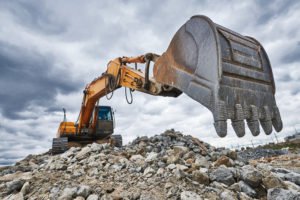Richard Broome, Managing Director at LSBUD, the online safe digging search resource, talks to us about the changes asset owners have been making in a bid to keep their networks and those that work around them safer than ever.
 ‘Striking’ an underground pipe or cable during excavation works is likely to have a substantial and long-lasting effect on the person involved, and depending on its severity, those around them too. With this in mind, it has never been more crucial that those responsible for digging are able to get an accurate picture of what is beneath them before a spade or digger bucket hits the ground.
‘Striking’ an underground pipe or cable during excavation works is likely to have a substantial and long-lasting effect on the person involved, and depending on its severity, those around them too. With this in mind, it has never been more crucial that those responsible for digging are able to get an accurate picture of what is beneath them before a spade or digger bucket hits the ground.
To ensure total accuracy, there are some changes asset owners can make, and in some cases have been making, to ensure their networks are visible and those digging near them stay safe.
Greater transparency with those that need it
Sharing data more effectively is the main way in which underground networks can become more visible. By making asset information available to a central, collaborative portal, it is there for all to see, meaning those responsible for digging work know where they can and can’t dig.
This might seem like an obvious action for asset owners to take, but there are still some remaining that don’t conform to this collaborative spirit. Currently, 1 million of the 1.5 million kilometres of underground networks are readily available on our system, meaning half a million kilometres are still incredibly vulnerable to being hit. Some sectors are worse than others, with the water industry being the biggest culprit, with just 15% of companies sharing their asset information. This means as much as 350,000 kilometres of water pipelines are currently unprotected. Gas and electricity companies are far more vigilant, with 80 and 70% respectively sharing their network data and both of these figures will increase during 2021.
We continue to see asset owners changing their behaviours and opening up their data so that others can benefit. They understand that the more Members registered and sharing their information, the more enquiries every utility company receives. This makes it much more likely that their assets will appear on all the searches they should appear on. This is called the ‘safety of the herd’ effect.
In addition, asset owners are using the portal to look for oversights that they would never have been able to identify before. The vast amount of search data gives them a much clearer picture of the vulnerability of their own infrastructure. By improving the understanding of digging around their assets, Members can see trends and make changes to better protect their assets in the present.
Futureproofing
Another key change that we have started to see is asset owners using their data combined with our search data to better protect their assets moving forward.
Asset owners are changing the way they see our portal, and this is benefiting them now and further down the line. The system does not just supply asset maps, it collects highly significant data about the activities taking place along the length and breadth of the UK’s networks. By acting as a two-way data exchange, the portal offers insights which utility companies can draw on. The system collects a huge amount of high quality, up-to-the minute data, which informs network operators of who is planning to work in the vicinity of their network, the type of work they are doing, when they are doing it and the exact locations.
Whilst this is useful in the short-term, a significant benefit for Members comes from the continued use of data, and the improved understanding of it. It means companies can begin to see trends, make predictions and identify ‘at risk’ excavations, based on high levels of data. This means that they can understand the very highest risk excavations near their network and focus their resources to help reduce this risk through predictive analytics.
Reducing this risk further protects assets and ensures that those doing the digging stay safe. All made possible by asset owners collaborating and changing the way they think, using the data available to improve performance for all.
In Summary
With a predicted surge in digging set to take place across 2021 and beyond, there will be more people doing more digging. This brings with it the risk of asset strikes, which can have catastrophic implications on people, their colleagues and families.
We are seeing great progress being made, through asset owners better understanding the benefits that come with sharing their network information and changing how they view and utilise the data available to them.
To keep the momentum up, and to keep people safe, we need the remaining asset holders to adapt their behaviours and join the safe digging revolution.
Excavation work has never been safer – as UK readies for ‘Digging Boom’

Excavation work is safer than ever, with 77% of all UK projects now preceded by a thorough search for pipes and cables, according to Digging up Britain 2021. The report by LSBUD reveals that over three million search enquiries were made for excavation works on its collaborative portal in 2020, a record-breaking figure. This means a search enquiry was placed every three seconds during the average working day.
Richard Broome, LSBUD’s MD, comments: “We’ve gone beyond a ‘tipping point’ in terms of safe digging, with searches going through our system more often than we blink. This is excellent news for both for the UK’s underground pipes and cables, and those who dig near them. Our data shows that performing a search on the LSBUD service before undertaking any digging work has been firmly established as a standard practice among construction workers and contractors. The practice is increasingly being adopted by the general public too.”
This is good news as the UK is set to experience a ‘digging boom’ in 2021. The report reveals that companies and the public used lockdown to plan for almost one million projects, including house and road building, extensions, broadband installation and road maintenance.
In 2020, LSBUD saw search enquiries for future projects rise significantly compared to the previous year – up 35% with 904,120 enquiries. As restrictions ease and the Government looks to kick-start the UK’s economy through investment in large-scale infrastructure projects, these are now starting to take place, swelling the estimated four million projects which routinely take place each year.
Richard Broome adds: “What’s also apparent is that the country’s underground pipes and cables have never been more visible, with more than 90 electricity, gas, oil and telecoms companies and other network owners now registered with LSBUD. This is just as well given the ‘digging boom’ that we’re starting to see.”
The majority of digging is done on behalf of the telecoms sector, with its contractors and operators completing 1,125,843 searches in 2020, 36% of the UK’s total. The water industry followed with 825,322 searches, accounting for 27%.
Searches amongst private individuals also rose in 2020 with 126,246 enquiries, equating to a nine % increase on the previous year, and a 97% rise on just four years ago.
Importantly for health and safety professionals, the report also identifies when incidents are most likely to happen. July has the most asset strikes, Tuesday is the most common day and between 10:00-13:00 is when strikes are most likely to occur. For high risk incidents, the ‘danger time’ is between 01:00 and 04:00.
Richard Broome continues: “This sort of intel is invaluable for those working in health and safety. It helps asset owners understand more about the activity taking place around their networks, allowing them to put greater measures in place. These better protect those doing the digging, so it is a win/win situation”.
There is still work to be done in order to ensure total safety of workers, contractors and the general public when it comes to digging. In 2020 there were still 1,526 safety related electrical incidents reported to the HSE, 79 of these were injury related. Gas related incidents have steadily come down since 2013, but with 1,162 reported to the HSE, more needs to be done.
Richard Broome concludes: “Personal safety could be drastically improved if all asset owners were to get involved in the collaborative portal. Whilst the number is growing fast, there are still 30% of electricity networks and 20% of gas networks that could share their asset information through LSBUD. And with regards to water companies, we have just 15% on our books, meaning those digging near its assets are doing so without a full picture of what is beneath them.
“I’d urge the remaining asset owners to recognise the benefits of sharing their information through our portal. A digging boom is coming, there has never been a better time to ensure your assets are properly visible.”
Click here or more information on LSBUD.
The Safety Conversation Podcast: Listen now!
The Safety Conversation with SHP (previously the Safety and Health Podcast) aims to bring you the latest news, insights and legislation updates in the form of interviews, discussions and panel debates from leading figures within the profession.
Find us on Apple Podcasts, Spotify and Google Podcasts, subscribe and join the conversation today!

 ‘Striking’ an underground pipe or cable during excavation works is likely to have a substantial and long-lasting effect on the person involved, and depending on its severity, those around them too. With this in mind, it has never been more crucial that those responsible for digging are able to get an accurate picture of what is beneath them before a spade or digger bucket hits the ground.
‘Striking’ an underground pipe or cable during excavation works is likely to have a substantial and long-lasting effect on the person involved, and depending on its severity, those around them too. With this in mind, it has never been more crucial that those responsible for digging are able to get an accurate picture of what is beneath them before a spade or digger bucket hits the ground.
